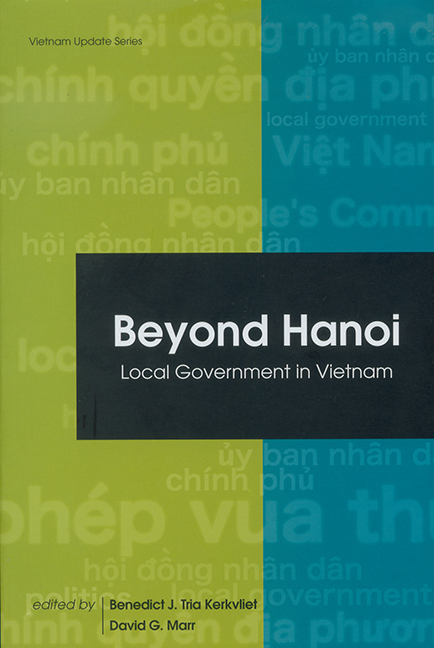Book contents
- Frontmatter
- Contents
- Preface
- Abbreviations
- 1 Surveying Local Government and Authority in Contemporary Vietnam
- 2 A Brief History of Local Government in Vietnam
- 3 Village Government in Pre-colonial and Colonial Vietnam
- 4 Caught in the Middle: Local Cadres in Hai Duong Province
- 5 Winter Crop and Spring Festival: The Contestations of Local Government in a Red River Delta Commune
- 6 Local Politics and Democracy in a Muong Ethnic Community
- 7 Local Government in the Exercise of State Power: the Politics of Land Allocation in Black Thai Villages
- 8 Urban Government: Ward-level Administration in Hanoi
- 9 The Facilitators of Rural Transformation and Development: The Role of Agricultural Extension Officers in Two Districts of Long An Province
- 10 Ho Chi Minh City's Post-1975 Political Elite: Continuity and Change in Background and Belief
- 11 Push, Pull, and Reinforcing: The Channels of FDI Influence on Provincial Governance in Vietnam
- Glossary of Vietnamese Terms
- Index
- About the Contributors
3 - Village Government in Pre-colonial and Colonial Vietnam
Published online by Cambridge University Press: 21 October 2015
- Frontmatter
- Contents
- Preface
- Abbreviations
- 1 Surveying Local Government and Authority in Contemporary Vietnam
- 2 A Brief History of Local Government in Vietnam
- 3 Village Government in Pre-colonial and Colonial Vietnam
- 4 Caught in the Middle: Local Cadres in Hai Duong Province
- 5 Winter Crop and Spring Festival: The Contestations of Local Government in a Red River Delta Commune
- 6 Local Politics and Democracy in a Muong Ethnic Community
- 7 Local Government in the Exercise of State Power: the Politics of Land Allocation in Black Thai Villages
- 8 Urban Government: Ward-level Administration in Hanoi
- 9 The Facilitators of Rural Transformation and Development: The Role of Agricultural Extension Officers in Two Districts of Long An Province
- 10 Ho Chi Minh City's Post-1975 Political Elite: Continuity and Change in Background and Belief
- 11 Push, Pull, and Reinforcing: The Channels of FDI Influence on Provincial Governance in Vietnam
- Glossary of Vietnamese Terms
- Index
- About the Contributors
Summary
When the French established their colonial regime in Vietnam in the second half of the nineteenth century they were confronted with villages that had reached a comparably high degree of autonomy towards the central administration. Many French observers were impressed by what they called “small republics” where the “equality of the citizens is absolute”. The system of village self-administration seemed to be advantageous for the colonial administration and to guarantee stability in the countryside. In 1875 a French colonial officer praised “the Vietnamese village”: “The instrument is old, it is good, it fits to the people. What interest should we have to change it?”
At the turn of the century, however, the initial admiration of Vietnamese villages mixed with criticism of the omnipotence of notables and with demands that counter-measures should be taken against that situation. The French first tried to introduce a stricter tax system and change the way local authorities collected taxes. In the following years, the French launched several ambitious reforms to make local government and finance more transparent and to change the recruitment mechanisms of officials to enhance their accountability.
Vietnam was divided into three parts under French rule. Northern Vietnam was Tonkin; central Vietnam, Annam; and southern Vietnam Cochinchina. This chapter focuses on the reform of village administration in Tonkin that the French launched in three consecutive steps after 1921. The reforms of village administration (cai luong huong chinh) and village customs (cai luong huong tuc) were a test-case for the French to make local officials accountable and introduce the electoral principle. I will not discuss developments in Annam because the French did not attempt to reform the system of village administration and the recruitment of local officials there. In Annam, it was only in 1942 that the French started to interfere with the formation of village councils of notables.
- Type
- Chapter
- Information
- Beyond HanoiLocal Government in Vietnam, pp. 54 - 89Publisher: ISEAS–Yusof Ishak InstitutePrint publication year: 2004



